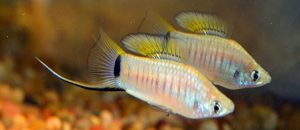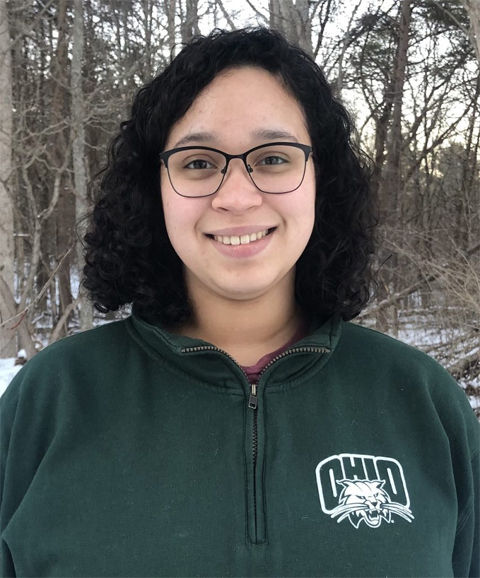Editor’s Note: The Happy Beginnings series features recent College of Arts & Sciences graduates who are getting started in careers, graduate school and service.
Shasta Kamara, a senior marine, freshwater, and environmental biology major, will be starting her master’s degree in Marine and Environmental Biology next fall at Nichols State University in Thibodaux, La., where she will be working on the invasive Asian carp problem.
But she got her start in research at OHIO, where she has been working in Dr. Molly Morris’s research lab since the fall of 2019.
Q: What was your ah-ha moment at OHIO—that point where you said to yourself, “I’ve got this!”?
“One of my favorite ah-ha moments at OHIO was when I finally was able to fully grasp the scientific concepts in my lab meetings,” says Kamara.
“Being new to a lab is often intimidating and hearing all the scientific jargon and big ideas being discussed was always so impressive to me. When I first started, I set out to have just as solid of an understanding of the concepts as the graduate students, as they were great role models in scientific understanding. After around a year of being in the lab, I finally had the ah-ha that I was fully participating in scientific discussions and even adding valuable contributions to them!”
Who were your favorite professors and how did they make an impact on your life?
“I greatly appreciate all my professors, in addition to my guidance from Dr. Molly Morris and my supervisors at the Voinovich School of Leadership and Public Affairs, I would have to say some of the most influential professors in my career so far have been Dr. Mark Lucas, Dr. Janet Duerr, and Dr. Matthew White. Dr. Lucas did an awesome job teaching physics material, and his passion for physics always showed in his lessons. This left me wanting to be just as passionate about my career! Dr. Duerr tackled teaching cell biology with just as much passion and was always incredibly animated when teaching and showed me that scientists should go outside the box and find more ways to make learning fun.
“And Dr. White passed on the life lesson that if given the chance, always try the fish! Dr. White and his incredible knowledge of fish gave me the confidence that I could go on to do the same. I also want to mention that all these professors made learning amid a pandemic much more enjoyable.”
Q: What are your favorite OHIO memories? What’s the one thing you would tell a new OHIO student not to miss?
“Some of my favorite OHIO memories are the moments with the people at Ohio University. Taking time to talk with professors, fellow lab members, and peers has given me a more complex view of life and has furthered my learning experience. I would tell a new OHIO student, do not miss out on the people! Professors at OHIO are incredibly engaged in their fields and have so much knowledge to share with you, get involved with your professional field early, and make connections with those around you,” Kamara says.
About Kamara’s Work in the Morris Lab
The Morris lab is working on a multitude of different questions about Northern Swordtail Fishes (Xiphophorus multilineatus) due to their varying mating behaviors, fat storage, body asymmetry, and brain size. Males fall into two categories: sneaker and courter males.
Dimorphism within a species could indicate intralocus tactical conflict, where selection on a trait in one type of male displaces the other type of male from its phenotypic optimum Although courter and sneaker males share a variety of traits, their phenotypes have evolved to be best suited for different strategies of obtaining mates.
“The best phenotype for being a courter male is not the best focus for being a sneaker male,” Morris says. The variation in growth rate between both populations also can be measured by counting the number of rings on the fish’s body. Morris and her researchers found that fish that grow faster as juveniles are asymmetrical, more likely to store fat and die sooner. While fishes that grow at a slower rate have symmetrical pigment patterns on both sides of their bodies and live for longer.
Morris’s research team consists of graduate and undergraduate students. Graduate students working in her lab are Meredith Fitschen-Brown, Keith Tompkins, Kevin Justus, and Neil Hamrick. Undergraduate students working in the lab are Kamara, Helen Stec, Kelsey Daniels, Connor Gensel, Madison Parker, Alissa Shull, Kana Wisniewski, and Morgan Radcliff.
Kamara’s duties in the lab have included behavioral studies such as aggression and mate preference testing, as well as photographing and measuring traits. Shasta is also a Voinovich Research Scholar, which has opened opportunities to further her own research experiences in preparation for entering graduate school. Through the scholar program, Shasta has been able to work with Athens mine drainage systems, watersheds, and Raccoon Creek in McArthur, Ohio, to further examine the conservation strategies in the area.
Article by Hannah Cordes




















Comments